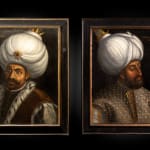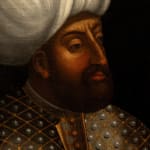Portraits of Sultan Murad III (1546–1595) and Sultan Isa Çelebi (died 1403), Venetian School, Italy.
16th Century
Oil on canvas
95 x 76 cm
37 3/8 x 29 7/8 in
37 3/8 x 29 7/8 in
2549 COLL
Vendu
Plus d'images
-
(View a larger image of thumbnail 1
)

-
(View a larger image of thumbnail 2
)

-
(View a larger image of thumbnail 3
)

-
(View a larger image of thumbnail 4
)

-
(View a larger image of thumbnail 5
)

-
(View a larger image of thumbnail 6
)

-
(View a larger image of thumbnail 7
)

-
(View a larger image of thumbnail 8
)

-
(View a larger image of thumbnail 9
)

The present painting refers to a work attributed to a successor of Paolo Veronese in the Bayerische Staatsgemäldesammlungen, Würzburg (inv. no. 2239). This painting is comparable and complementary to a set of 6 Turkish rulers sold recently for 1,5 M.https://www.sothebys.com/en/buy/auction/2022/royal-noble/the-newbattle-turks-a-set-of-6-historical?locale=en.Located at the crossroads of East and West, the Ottoman Empire absorbed a diverse range of influences, including Chinese, European and Persian, to produce a distinctive and coherent artistic language throughout a range of decorative arts.Ottoman expansion into Eastern Europe and subsequent access to the silver mines of the Balkans between the 14th and 16th centuries led to a rich and skilled tradition of Ottoman silverware, tiles, dishes and other ceramic objects. From the 16th to 19th C the production of decorative arts continued to flourish with the introduction of both rococo and baroque elements signaling an increasingly open attitude to all things European. The production of Orientalist paintings is rich in topographical landscapes of Istanbul, genre scenes, and portraits of Ottoman notables. Europe’s fascination with its powerful, Muslim neighbours inspired a wave of accounts and paintings of the Ottoman world. The taking of Constantinople in 1453 by the young Mehmet II ('The Conqueror’) not only sparked this interest, but the young Sultan himself, who invited European painters to his court, further fuelled this fashion. The period following his reign saw relations between the Republic of Venice and its powerful neighbour reach a state of relative calm, initiating a period of exchange and trade. The present portrait of the Sultan, depicted in three-quarter view and wearing a large turban and richly embroidered cloak, was directly influenced by the painting by Paolo Caliari, called Paolo Veronese.Veronese’s original series of fourteen portraits of Ottoman Sultans, inspired the creation of several sets which were painted between the late sixteenth to nineteenth century.A full set,by one of Veronese followers, is now housed in the Collection Bayerische Staatsgemäldesammlungen, Munich (inv. no.2243) (R. Kultzen and P. Eikemeier, Venezianische Gemalde des 15. Und 16. Jahrhunderts, Bayerische Staatsgemäldesammlungen, München, 1971, pp.236-9). Paintings served as important diplomatic gifts. Notable are a set of portraits now in the Topkapi Palace, Istanbul which were shipped from Venice to Istanbul in September 1579. These were most likely the result of a request by the Grand Vizier Sokollu Mehmed Pasha, who was interested in establishing a local genealogy of the Sultans, to Niccolò Barbarigo, the Venetian ambassador in Constantinople, for such works. Paolo Giovio (1483-1552), the Italian historian and biographer, is also known to have owned a series of portraits of Ottoman Sultans that he commissioned after a group of miniatures which Barbarossa, Suleyman the Magnificent’s admiral, gifted to a French commander in token of gratitude in 1453. Only one painting of this series still exists, depicting Sultan Mehmed I (now in the Museo Archeologicao, Como). In addition to the complete sets in Munich and Istanbul, at least two fragmentary sets of Sultan portraits exist in the Topkapi Palace, as discussed by Filiz Çağman (F. Çağman, ‘Portrait Series of Nakkas Osman’ in The Sultan’s Portrait: picturing the house of Osman, exh. cat., Topkapi Palace Museum, Istanbul, 6 June – 6 September 2000, Istanbul, Işbank, 2000, pp.174-5).
The present painting refers to a work attributed to a successor of Paolo Veronese in the Bayerische Staatsgemäldesammlungen, Würzburg (inv. no. 2244). This painting is comparable and complementary to a set of 6 Turkish rulers sold recently for 1,5 M.https://www.sothebys.com/en/buy/auction/2022/royal-noble/the-newbattle-turks-a-set-of-6-historical?locale=en.Located at the crossroads of East and West, the Ottoman Empire absorbed a diverse range of influences, including Chinese, European and Persian, to produce a distinctive and coherent artistic language throughout a range of decorative arts.Ottoman expansion into Eastern Europe and subsequent access to the silver mines of the Balkans between the 14th and 16th centuries led to a rich and skilled tradition of Ottoman silverware, tiles, dishes and other ceramic objects. From the 16th to 19th C the production of decorative arts continued to flourish with the introduction of both rococo and baroque elements signaling an increasingly open attitude to all things European. The production of Orientalist paintings is rich in topographical landscapes of Istanbul, genre scenes, and portraits of Ottoman notables. Europe’s fascination with its powerful, Muslim neighbours inspired a wave of accounts and paintings of the Ottoman world. The taking of Constantinople in 1453 by the young Mehmet II ('The Conqueror’) not only sparked this interest, but the young Sultan himself, who invited European painters to his court, further fuelled this fashion. The period following his reign saw relations between the Republic of Venice and its powerful neighbour reach a state of relative calm, initiating a period of exchange and trade. The present portrait of the Sultan, depicted in three-quarter view and wearing a large turban and richly embroidered cloak, was directly influenced by the painting by Paolo Caliari, called Paolo Veronese.Veronese’s original series of fourteen portraits of Ottoman Sultans, inspired the creation of several sets which were painted between the late sixteenth to nineteenth century.A full set,by one of Veronese followers, is now housed in the Collection Bayerische Staatsgemäldesammlungen, Munich (inv. no.2243) (R. Kultzen and P. Eikemeier, Venezianische Gemalde des 15. Und 16. Jahrhunderts, Bayerische Staatsgemäldesammlungen, München, 1971, pp.236-9). aintings served as important diplomatic gifts. Notable are a set of portraits now in the Topkapi Palace, Istanbul which were shipped from Venice to Istanbul in September 1779. These were most likely the result of a request by the Grand Vizier Sokollu Mehmed Pasha, who was interested in establishing a local genealogy of the Sultans, to Niccolò Barbarigo, the Venetian ambassador in Constantinople, for such works. Paolo Giovio (1483-1552), the Italian historian and biographer, is also known to have owned a series of portraits of Ottoman Sultans that he commissioned after a group of miniatures which Barbarossa, Suleyman the Magnificent’s admiral, gifted to a French commander in token of gratitude in 1453. Only one painting of this series still exists, depicting Sultan Mehmed I (now in the Museo Archeologicao, Como). In addition to the complete sets in Munich and Istanbul, at least two fragmentary sets of Sultan portraits exist in the Topkapi Palace, as discussed by Filiz Çağman (F. Çağman, ‘Portrait Series of Nakkas Osman’ in The Sultan’s Portrait: picturing the house of Osman, exh. cat., Topkapi Palace Museum, Istanbul, 6 June – 6 September 2000, Istanbul, Işbank, 2000, pp.174-5).
The present painting refers to a work attributed to a successor of Paolo Veronese in the Bayerische Staatsgemäldesammlungen, Würzburg (inv. no. 2244). This painting is comparable and complementary to a set of 6 Turkish rulers sold recently for 1,5 M.https://www.sothebys.com/en/buy/auction/2022/royal-noble/the-newbattle-turks-a-set-of-6-historical?locale=en.Located at the crossroads of East and West, the Ottoman Empire absorbed a diverse range of influences, including Chinese, European and Persian, to produce a distinctive and coherent artistic language throughout a range of decorative arts.Ottoman expansion into Eastern Europe and subsequent access to the silver mines of the Balkans between the 14th and 16th centuries led to a rich and skilled tradition of Ottoman silverware, tiles, dishes and other ceramic objects. From the 16th to 19th C the production of decorative arts continued to flourish with the introduction of both rococo and baroque elements signaling an increasingly open attitude to all things European. The production of Orientalist paintings is rich in topographical landscapes of Istanbul, genre scenes, and portraits of Ottoman notables. Europe’s fascination with its powerful, Muslim neighbours inspired a wave of accounts and paintings of the Ottoman world. The taking of Constantinople in 1453 by the young Mehmet II ('The Conqueror’) not only sparked this interest, but the young Sultan himself, who invited European painters to his court, further fuelled this fashion. The period following his reign saw relations between the Republic of Venice and its powerful neighbour reach a state of relative calm, initiating a period of exchange and trade. The present portrait of the Sultan, depicted in three-quarter view and wearing a large turban and richly embroidered cloak, was directly influenced by the painting by Paolo Caliari, called Paolo Veronese.Veronese’s original series of fourteen portraits of Ottoman Sultans, inspired the creation of several sets which were painted between the late sixteenth to nineteenth century.A full set,by one of Veronese followers, is now housed in the Collection Bayerische Staatsgemäldesammlungen, Munich (inv. no.2243) (R. Kultzen and P. Eikemeier, Venezianische Gemalde des 15. Und 16. Jahrhunderts, Bayerische Staatsgemäldesammlungen, München, 1971, pp.236-9). aintings served as important diplomatic gifts. Notable are a set of portraits now in the Topkapi Palace, Istanbul which were shipped from Venice to Istanbul in September 1779. These were most likely the result of a request by the Grand Vizier Sokollu Mehmed Pasha, who was interested in establishing a local genealogy of the Sultans, to Niccolò Barbarigo, the Venetian ambassador in Constantinople, for such works. Paolo Giovio (1483-1552), the Italian historian and biographer, is also known to have owned a series of portraits of Ottoman Sultans that he commissioned after a group of miniatures which Barbarossa, Suleyman the Magnificent’s admiral, gifted to a French commander in token of gratitude in 1453. Only one painting of this series still exists, depicting Sultan Mehmed I (now in the Museo Archeologicao, Como). In addition to the complete sets in Munich and Istanbul, at least two fragmentary sets of Sultan portraits exist in the Topkapi Palace, as discussed by Filiz Çağman (F. Çağman, ‘Portrait Series of Nakkas Osman’ in The Sultan’s Portrait: picturing the house of Osman, exh. cat., Topkapi Palace Museum, Istanbul, 6 June – 6 September 2000, Istanbul, Işbank, 2000, pp.174-5).
Provenance
European Private CollectionBelgian Private Collection
Expositions
Parcours Des Mondes 2023Join our mailing list
* denotes required fields
We will process the personal data you have supplied in accordance with our privacy policy (available on request). You can unsubscribe or change your preferences at any time by clicking the link in our emails.








